
Erucaria hispanica / خزام
Bunias myagroides L., Sinapis hispanica L. Erucaria boveana Coss., Erucaria aleppica Gaertn Erucaria grandiflora Boiss, Erucaria lineariloba Boiss
Salih, Khezaam
Spanish pink mustard
Khezaam
Brassicaceae

Flowers
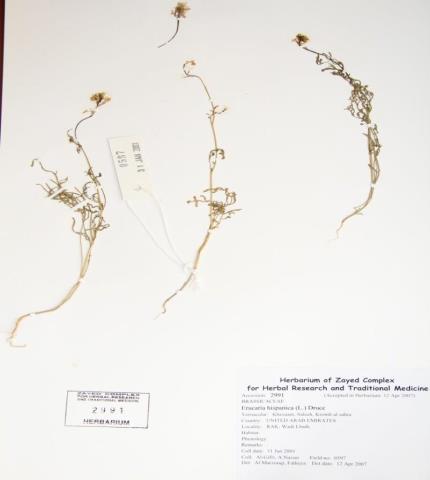
Herbarium specimen
Ethnobotanical Characteristics
Description
Annual or biennial, up to 80 cm tall, branched from below, glabrous or sparsely hispid below with simple hairs. Leaves bipinnatisect with very narrow lobes, petiolate, ± fleshy; basal subrosulate, 10-18 cm long, 3-5.5 cm broad; middle and upper leaves much smaller; lateral lobes 3-5, alternate, narrowly linear, 1-4 mm broad, those of uppermost leaves often filiform, sparsely lobulate or irregularly dentate. Racemes 30-45-flowered, lax, increasing up to 40 cm in fruit, ebracteate. Flowers about 1 cm across, mauve; pedicel 1-2 mm long, hardly increasing in fruit, thickened, appressed. Sepals 5-7 mm long, 1.2 mm broad. Petals 11-13 mm long, 4-5 mm broad, obovate, clawed. Stamens 7-9: 8-10 mm long; anthers about 1.5 mm long. Siliquae (7-) 10-15 (-17) mm long, biarticulated, torulose, erect or slightly curved; lower cylindrical part 4-6 mm long, 1-1.5 mm broad, usually 4-6 seeded, with coriaceous valves; upper part about as long as the lower part, but 1.5-3 mm broad, compressed with 3-5-veined valves, 1-3-seeded, breaking away as an unit; beak 2-4 mm long, narrow style-like; seeds ellipsoid or suborbicular, about 1 mm long. (Jongbloed et al. 2003, eFloras, Mandaville,1990).
Habitat and Distribution
Normally grow in sandy areas and found in S. Europe, Northern Africa, Arabia, Anatolia, Syria, Iraq, Iran and Western Pakistan. Fairly common in foot hills up to 1000 feet asl, found in hills North of Masafi area. (A.R. Western, 1989).
Traditional and Medicinal Uses
Traditional uses of this plant are not available in literature, however, cytotoxic activity of Erucaria hispanica is well established (Marzouck, 2011).
Part(s) Used
Dried leaf
Pharmacognosy and Phytochemistry
Dried leaf
General appearance
The leaf is narrow, linear and segmented. It is light brown and brittle.
Microscopical characteristics
A surface view of the leaf shows that it has prominent but not intricate venation, and the vessels are annularly and spirally thickened. The upper epidermis consist of oblong cells with sinuous walls while the lower epidermis consists of polygonal cells or cells having irregular shapes but both types have sinuous cell walls. The stomata are present at the lower epidermis; they are oval to oblong shape, and they are of the anisocytic type. A transverse section of the leaf shows that it is dorsiventral and both epidermises are observed to consist of small oval cells. The palisade tissue is represented by one layer beneath the upper epidermis, and the cells are short and loosely packed. The spongy mesophyll cells are rounded in shape, and many of them contain yellowish brown amorphous materials.
Dried stem and branches
General appearance
The stem and branches are slender and thin. The branches are grayish brown with a pinkish tint. They attain a thickness of about 1-1.5 mm and they are brittle.
Herbarium specimen
Microscopic characteristics
A surface view of the stem shows that the epidermal cells are elongated with some stomata are found between the distal parts of adjacent cells on the same row of cells. A transverse section through the branch shows that the epidermis, which undulates in arch forms; consists of almost rounded cells. This epidermal layer surrounds about four layers of small cortical parenchyma cells that are polygonal in shape, although some of them are compressed or distorted. The vascular tissues seem to be in isolated groups between the cortical cells. The cortical parenchyma cells are similar to those of the pith as if there was an extension between the cortex and the pith. The pith is represented by a very large central zone that consists of polygonal or rounded cells of different sizes, but they are relatively larger than those of the cortex. Only the xylem fibers and xylem vessels (which are annularly, spirally or reticularly thickened) are moderately lignified; phloem tissues and vascular parenchyma cells are unlignified.
Powdered plant material
The material consists of the pounded aerial parts. It is a light green yellow heterogeneous coarse powder that contains comparatively large whitish fragments of stem or branches. It has a slight straw-like odour and a little spicy, mucilaginous taste. Microscopically, the powder shows light green leaf fragments with significant sinuous walls of the epidermal layers and the rounded spongy mesophyll cells with their contents of yellowish- brown amorphous materials, which are mostly observed in cells around the vascular tissues. Also showing are the elongated epidermal cells of the stem and branches with stomata existing between their narrow distal ends. Large polygonal cells of the pith with their well-defined cell walls are also observed.
Parts studied
stem

A) TS of stem
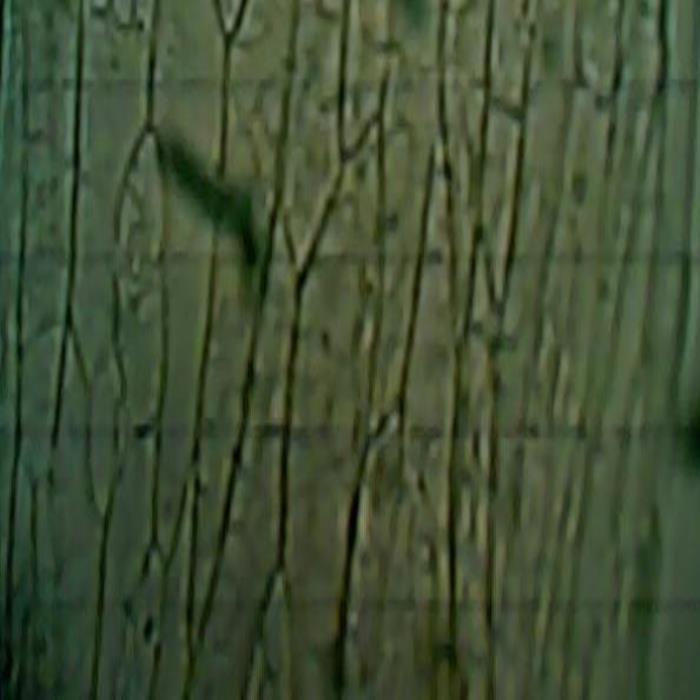
B) Surface view of stem

C) Spongy mesophyll
- A. A TS of a portion of the stem showing the epidermis with its almost rounded cells and its undulations into arch forms underlain by few layers of compressed parenchyma cells; groups of vascular tissues; in between cortical cells that are similar in shape to pith cells which are comparatively larger.
- B. A surface view of the stem showing the elongated epidermal cells enclosing some stomata.
- C. A surface view in depth of the leaf showing the cells of spongy mesophyll with their contents of yellowish brown amorphous materials.
Chemical Constituents
Thirteen flavonoids were isolated for the first time from the aerial parts of Erucaria hispanica (L.) Druce growing in Egypt. The structures of the flavonoids were established on the basis of detailed chromatographic and spectroscopic techniques (UV, 1D and 2D NMR and ESIMS) (Marzouk,2011).
The following chemical studies have been carried out on the plant Erucaria hispanica (Quality Control methods, 1998; Evans, 1996) (ZCHRTM unpublished work):
Physicochemical constants
Loss of weight in drying at 105°C : 10.20
Absolute alcohol solubility (%) : 2.00
Water solubility (%) : 37.00
Successive extractives (%)
Petroleum ether (60-80) °C : 1.00
Chloroform : 1.60
Ash values (%)
Total ash : 19.00
Water soluble ash : 10.00
pH values (aqueous solution)
pH of 1% solution : 5.504-5.516
pH of 10% solution : 5.233-5.241
Elemental analyses
Ash values (British Herbal Pharmacopeia)
Assay and identification of element (AOAC International)
|
Apparatus |
AA-6800 Shimadzu-Flame method |
||||
| Element | Std. conc. µg/ml | Sampleconc.mg/ml | Sample absorbance | Actual conc.mg/ml | Actual conc.(%) |
|
Cr |
1, 2, 4 |
20 |
0.0037 |
0.00429 |
0.000429 |
|
Zn |
0.25, 0.5, 1 |
20 |
0.564 |
0.02605 |
0.002605 |
|
Cu |
1, 2, 4 |
20 |
0.0270 |
0.00744 |
0.000744 |
|
Fe |
1, 2, 4 |
20 |
0.544 |
0.21884 |
0.021884 |
|
K |
1, 2, 4 |
1 |
1.6308 |
14.6755 |
1.46755 |
|
Pb |
1, 2, 4 |
20 |
0.0032 |
0.0048250 |
0.0004825 |
|
Cd |
0.25, 0.5, 1 |
20 |
0.0000 |
0.0000 |
0.0000 |
|
Ca |
5, 10, 20 |
1 |
0.0649 |
12.1752998 |
1.21752998 |
UV Spectral studies
|
Ultraviolet Spectrum (USP reference) |
||||
|
Apparatus |
Milton Roy Spectronic Genesys 5 Spectrophotometer - Milton Roy |
|||
|
Sample conc. (mg / ml) |
Solvent |
λ max (nm) |
λ min (nm) |
Abs.( λ max - λ min) |
|
1.025 |
Intestinal Fluid simulated without pancreatic pH=7.50.1 |
268 |
256 |
0.922 - 0.894 |
|
1.01 |
Gastric Fluid simulated without pepsin pH =1.20.1 |
265 316 |
256 305 |
0.722 - 0.704 0.510-0.508 |

Intestinal Fluid simulated without pancreatic
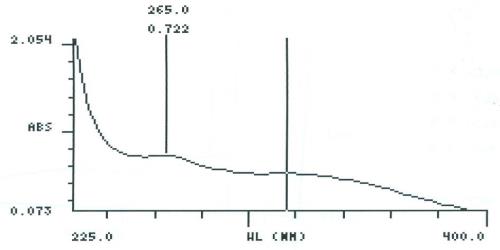
Gastric fluid simulated without pepsin
Chromatographic Studies
Thin layer chromatography (Wagner and Bladt, 1996)

A
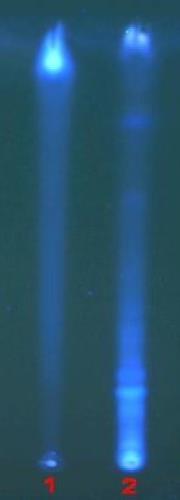
B
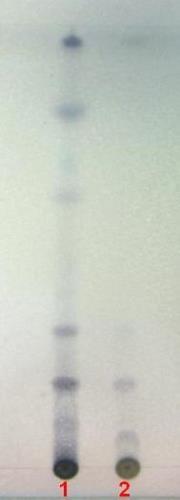
C
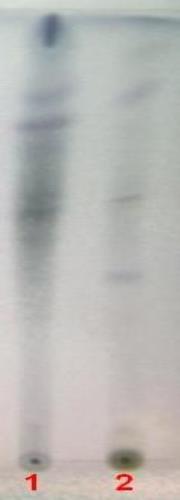
D
TLC fingerprint of Petroleum ether 60-80°C (track 1) and Methanol extract (track 2)
Mobile phase Fig. A& B: Ethyl acetate, methanol, water (100:13.5:10)
C: Toluene, ethyl acetate (93:7)
D: Toluene, ethyl formate, formic acid (5:4:1)
Detection A: UV 254nm
B: UV 366nm
Derivatization C&D: Vanillin-Sulphuric acid -vis
Pharmacological and toxicological studies
A summary of the important biological activities of the plant Erucaria hispanica reported in various scientific journals is presented review:
Spanish Mustard (Erucaria hispanica-Fam. Cruciferae) syn. Erucaria aleppica -Gaertn. Erucaria myagroides - Halacsy. Erucaria tenuifolia - DC. The plant prefers light (sandy), medium (loamy) and heavy (clay) soils. The plant prefers acid, neutral and basic (alkaline) soils. It can grow in semi-shade (light woodland) or no shade. It requires moist soil. Cytological studies of Erucaria hispanica (2n = 14) showed 2 M, 4 nm, 6 nsm (-) and 2 nsm (+) chromosomes and (2n = 16) had 2 M, 6 nm, 6 nsm (-) and 2 nsm (+) chromosomes. This creates the possibility of using the studied taxa as natural genetic resources, which are broadly used today in the field of conservation biology (Magda, 2002). The volatile constituents of E. microcarpa showed higher activity against yeasts than Gram +ve, Gram -ve bacteria and fungi. The non-methylated fatty acids of the two herbs showed higher activity against Gram +ve and Gram -ve bacteria than yeasts and fungi (Hashem, 1999).
The following pharmacological and safety evaluation studies were carried out on the aqueous plant extract of Erucaria hispanica (Derelanko 2002; Han, 2003).
|
ACTIVITY |
RESULTS |
|||
|
Strong |
Moderate |
Mild |
Negative |
|
|
Analgesic |
|
|
|
√ |
|
Antidepressant |
√ |
|
|
|
|
Anticonvulsant |
|
|
|
√ |
| Anti-diarrheal | √ | |||
|
Gastrointestinal activity |
|
|
|
√ |
|
Anti-gastric ulcer& cyto-protective activity |
√ |
|
|
|
|
Effect on rabbit jejunum |
√ |
|
|
|
|
Effect on Guinea pig ileum |
|
|
√ |
|
|
Effect on Guinea pig tracheal chain |
|
|
|
√ |
|
Effect on right rat atria |
|
|
|
√ |
|
Evaluation BP and HR on anaesthetized rats (HR ↑) |
|
|
√ |
|
|
Antithrombotic effect |
|
|
|
√ |
|
Effect on onset and duration of pentobarbitone sleeping ↓ |
|
√ |
|
|
|
Studies on biochemical parameters |
|
|
√ |
|
|
Studies on hematological parameters (HGB ↑) |
√ |
|
|
|
|
Vital organs weight |
|
|
|
√ |
|
Locomotor activity test |
|
|
|
√ |
|
Motor co-ordination (grip strength & motor activity |
|
|
|
√ |
|
Rectal temperature |
|
|
|
√ |
|
Body weight |
|
|
|
√ |
|
Vital organs |
|
|
|
√ |
|
Mortality |
|
|
|
√ |
Summary of the results
Relaxation/ antispasmodic, antidiarrheal/ antisecretory activity were present. It might produce relief of gastrointestinal spasm and improve the digestion. It exhibited significant inhibition of gastric mucosal damage induced by NaOH and Ethanol-induced gastric ulcer.

Antidepressant effect
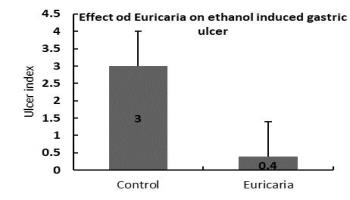
Effect on gastric ulcer
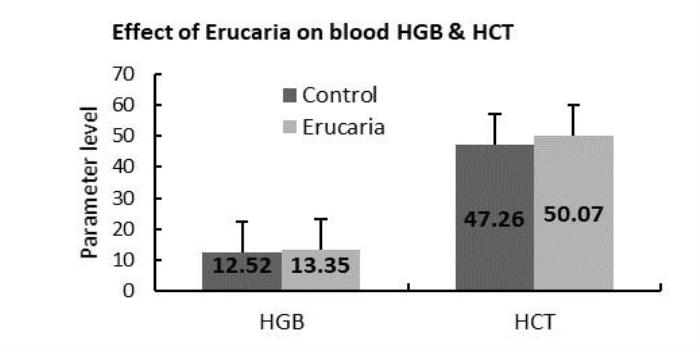
Effect on blood

Effect on spontaneous contraction of isolated rabbit jejunum
Antimicrobial activity
The aqueous extract of the whole plant was tested against Mycobacterium smegmatis, C. tropicalis, different strains of Staphylococcus aureus (Including ATCC 257) as well as Methicillin Resistant Staphylococcus aureus, different strains of E. coli (Including ATCC UN 109), different strains of ESBL-producing K. pneumonia, Pseudomonas aeruginosa, and showed no inhibition of growth.
References
- Ahmad Mohammad Migahid. Flora of Saudi Arabia, Vol.1, Riyadh University Publication, 1978.
- El-Ghonemy, A. A. (1993). Encyclopedia of Medicinal plants of the United Emirates. 1st Edition. University of U.A.E.
- Fawzi, M. K. (1995). Weeds in the United Arab Emirates. University of U.A.E. Flora of Pakistan: Database of www.efloras.org
- HaShem FA, Saleh M M. Antimicrobial components of some cruciferae plants (Erucaria microcarpa Boiss. Phytother Res. 1999 13(4):329-32.
- Jonbloed, M. V., Feulner, G. R., Boer, B. & Western, A. R. (2003). The comprehensive Guide to the Wild Flowers of the United Arab Emirates, Erwda, Abu Dhabi, U.A.E.
- Magda Ibrahim Soliman , Socio biological Studies on Some Wild Species of Family Cruciferae in Egypt; Pakistan Journal of Biological Sciences 2002, 5 (9): 943-947.
- Mandaville, J. P. (1990). Flora of Eastern Saudi Arabia. Kegan Paul International, Riyadh, Saudi Arabia.
- Miller, A. G. and M. Morris . 1988. Plants of Dhofar, The Southern Region of Oman. Traditional Economic and Medicinal Uses. Diwan of Royal Court Sultanate of Oman—Holmes MC Dougall, Edinburgh, Scotland.
- M.M. Marzouk, Flavonoid constituents and cytotoxic activity of Erucaria hispanica (L.) Druce growing wild in Egypt, Arabian Journal of Chemistry available online 24 May 2011.
- Western, A. R. (1986;1989).. The Flora of United Arab Emirates. An introduction. – Publications of the U.A.E. University.
